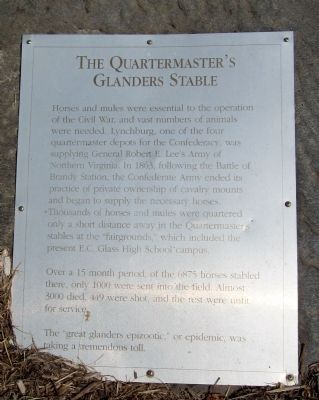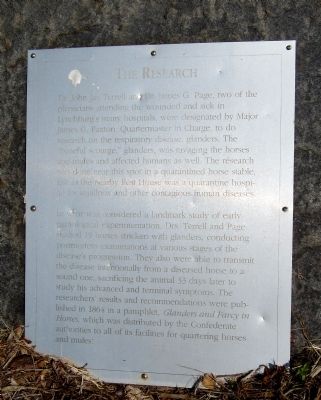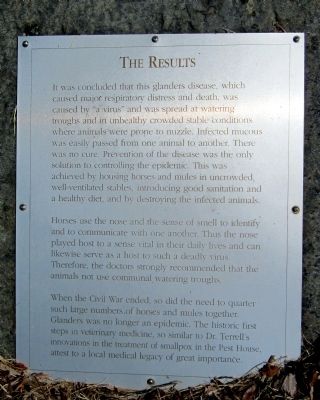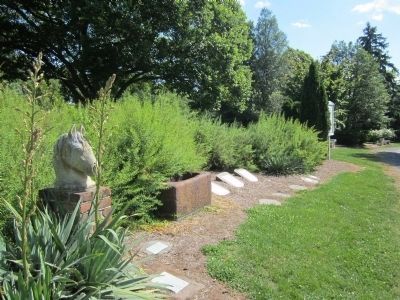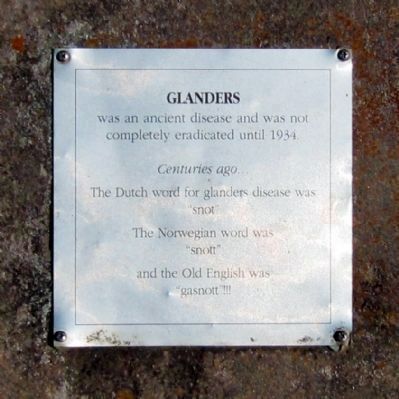Tinbridge Hill in Lynchburg, Virginia — The American South (Mid-Atlantic)
The Quartermaster’s Glanders Stable
Horses and mules were essential to the operation of the Civil War, and bass numbers of animals were needed. Lynchburg, one of the four quartermaster depots for the Confederacy, was supplying General Robert E. Lee's Army of Northern Virginia. In 1863, following the Battle of Brandy Station, the Confederate Army ended its practice of private ownership of cavalry mounts and began to supply the necessary horses. Thousands of horses and mules were quartered only a short distance away in the Quartermaster’s stables at the “fairgrounds,” which included the present E.C. Glass High School campus.
Over a 15 month period, of the 6875 horses stabled there, only 1000 were sent into the field. Almost 3000 died. 449 were shot, and the rest were unfit for service.
The “great glanders epizootic,” or epidemic, was taking a tremendous toll.
The Research
Dr. John J. Terrell and Dr. James G. Page, tow of the physicians attending the wounded and sick in Lynchburg’s many hospitals, were designated by Major James G. Paxton, Quartermaster in Charge, to do research on the respiratory disease, glanders. The “baneful scourge,” glanders, was ravaging the horses and mules and affected humans as well. The research was done near this spot in a quarantined horse stable, just as the nearby Pest House was a quarantine hospital for smallpox and other contagious human diseases.
In what was considered a landmark study of early pathological experimentation, Drs. Terrell and Page studied 19 horses stricken with glanders, conducting postmortem examinations at various stages of the disease’s progression. They also were able to transmit the disease intentionally from a diseased horse to a sound one, sacrificing the animal 33 days later to study his advanced and terminal symptoms. The researchers’ results and recommendations were published in 1864 in a pamphlet, Glanders and Farcy in Horses, which was distributed by the Confederate authorities to all of its facilities for quartering horses and mules.
The Results
It was concluded that this glanders disease, which caused major respiratory distress and death, was caused by “a virus” and was spread at watering troughs and in unhealthy crowded stable conditions where animals were prone to nuzzle. Infected mucous was easily passed from one animal to another. There was no cure. Prevention of the disease was the only solution to controlling the epidemic. This was achieved by housing horses and mules in uncrowded, well-ventilated stables, introducing good sanitation and a healthy diet, and by destroying the infected animals.
Horses use the nose and the sense of smell to identify and to communicate with one another. Thus the nose played host to a sense vital in their daily lives and can likewise serve as a host to such a deadly virus. Therefore, the doctors strongly recommended that the animals not use communal watering trough.
When the Civil War ended, so did the need to quarter such large numbers of horses and mules together. Glanders was no longer an epidemic. The historic first steps in veterinary medicine, so similar to Dr. Terrell’s innovations in the treatment of smallpox in the Pest House, attest to a local medical legacy of great importance.
Topics. This historical marker is listed in these topic lists: Animals • Science & Medicine • War, US Civil. A significant historical year for this entry is 1863.
Location. This marker has been replaced by another marker nearby. It was located near 37° 24.831′ N, 79° 9.438′ W. Marker was in Lynchburg, Virginia. It was in Tinbridge Hill. Marker could be reached from the intersection of Taylor Street and 4th Street. Touch for map. Marker was at or near this postal address: 401 Taylor Street, Lynchburg VA 24501, United States of America. Touch for directions.
Other nearby markers. At least 8 other markers are within walking distance of this location. Site of Glanders Stable (here, next to this marker); Glanders (here, next to this marker); a different marker also named The Quartermaster's Glanders Stable (a few steps from this marker); Stone Watering Trough (a few steps from this marker); Ivy Chapel Union Church (a few steps from this marker); Chapel and Columbarium (a few steps from this marker); Hermon Methodist Church (a few steps from this marker); Ministers, Trustees and Other Religious Leaders (a few steps from this marker). Touch for a list and map of all markers in Lynchburg.
Related marker. Click here for another marker that is related to this marker. New Marker At This Location also titled "The Quartermaster's Glanders Stable".
Also see . . . The Civil War Quartermaster's Glanders Stable. Old City Cemetery. (Submitted on May 28, 2014.)
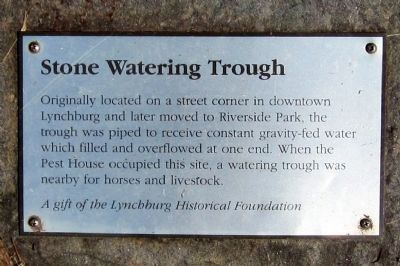
Photographed By Bernard Fisher, May 26, 2014
6. Stone Watering Trough
Originally located on a street corner in downtown Lynchburg and later moved to Riverside Park, the trough was piped to receive constant gravity-fed water which filled and overflowed at one end. When the Pest House occupied the site, a watering trough was nearby for horses and livestock.
A gift of the Lynchburg Historical Foundation
A gift of the Lynchburg Historical Foundation
Credits. This page was last revised on February 1, 2023. It was originally submitted on May 28, 2014, by Bernard Fisher of Richmond, Virginia. This page has been viewed 701 times since then and 19 times this year. Photos: 1, 2, 3. submitted on May 28, 2014, by Bernard Fisher of Richmond, Virginia. 4. submitted on May 27, 2014, by Bernard Fisher of Richmond, Virginia. 5, 6. submitted on May 28, 2014, by Bernard Fisher of Richmond, Virginia.
